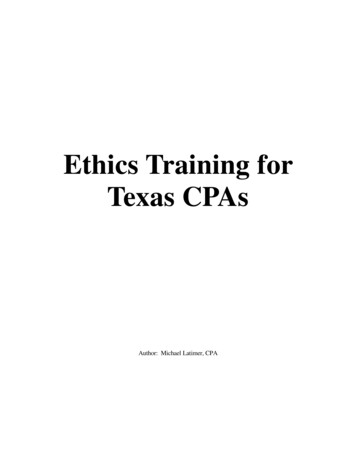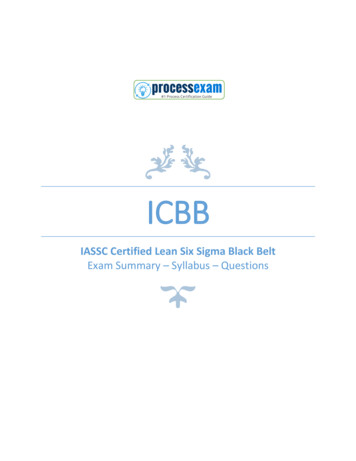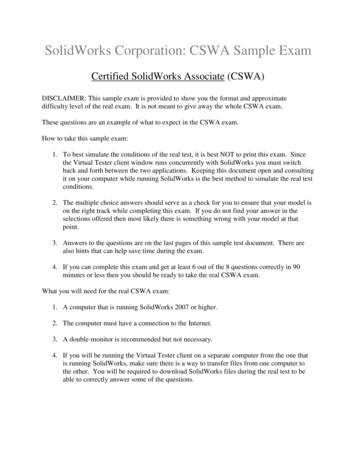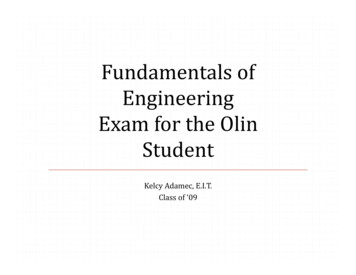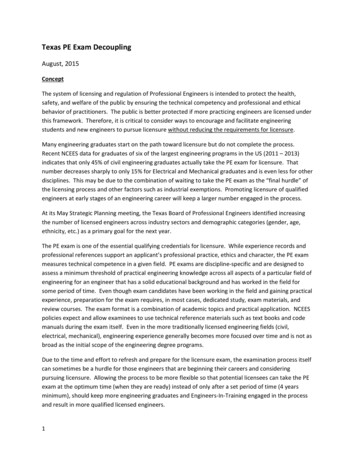
Transcription
Texas PE Exam DecouplingAugust, 2015ConceptThe system of licensing and regulation of Professional Engineers is intended to protect the health,safety, and welfare of the public by ensuring the technical competency and professional and ethicalbehavior of practitioners. The public is better protected if more practicing engineers are licensed underthis framework. Therefore, it is critical to consider ways to encourage and facilitate engineeringstudents and new engineers to pursue licensure without reducing the requirements for licensure.Many engineering graduates start on the path toward licensure but do not complete the process.Recent NCEES data for graduates of six of the largest engineering programs in the US (2011 – 2013)indicates that only 45% of civil engineering graduates actually take the PE exam for licensure. Thatnumber decreases sharply to only 15% for Electrical and Mechanical graduates and is even less for otherdisciplines. This may be due to the combination of waiting to take the PE exam as the “final hurdle” ofthe licensing process and other factors such as industrial exemptions. Promoting licensure of qualifiedengineers at early stages of an engineering career will keep a larger number engaged in the process.At its May Strategic Planning meeting, the Texas Board of Professional Engineers identified increasingthe number of licensed engineers across industry sectors and demographic categories (gender, age,ethnicity, etc.) as a primary goal for the next year.The PE exam is one of the essential qualifying credentials for licensure. While experience records andprofessional references support an applicant’s professional practice, ethics and character, the PE exammeasures technical competence in a given field. PE exams are discipline‐specific and are designed toassess a minimum threshold of practical engineering knowledge across all aspects of a particular field ofengineering for an engineer that has a solid educational background and has worked in the field forsome period of time. Even though exam candidates have been working in the field and gaining practicalexperience, preparation for the exam requires, in most cases, dedicated study, exam materials, andreview courses. The exam format is a combination of academic topics and practical application. NCEESpolicies expect and allow examinees to use technical reference materials such as text books and codemanuals during the exam itself. Even in the more traditionally licensed engineering fields (civil,electrical, mechanical), engineering experience generally becomes more focused over time and is not asbroad as the initial scope of the engineering degree programs.Due to the time and effort to refresh and prepare for the licensure exam, the examination process itselfcan sometimes be a hurdle for those engineers that are beginning their careers and consideringpursuing licensure. Allowing the process to be more flexible so that potential licensees can take the PEexam at the optimum time (when they are ready) instead of only after a set period of time (4 yearsminimum), should keep more engineering graduates and Engineers‐In‐Training engaged in the processand result in more qualified licensed engineers.1
It is critical to point out that this change would not result in a reduction of the requirements forlicensure. All three components for licensure (Education, Experience and Exams) must be completedprior to a license being granted.“It may provide a measure of convenience for potential licensees whose work experiencemight be narrowly focused and who might be more apt to take the exam earlier. Thiscould encourage the licensure of more engineers. For a young engineer who passes theexam early, the likelihood that he or she will become a professional engineer issignificantly increased.” – NSPE letter to NCEES May, 2012Requested InputAt its May 2015 meeting, the Licensing Committee directed staff to contact interested stakeholders inthe engineering community of Texas to get feedback on this potential change. Although some mixedcomments were received, the majority of opinion was favorable.ACEC – Texas (Steve Stagner, President) ‐“This issue was discussed at our board meeting last week and the group did not have any problems withthe concept.”TSPE (Nancy Blackwell, P.E., President) ‐“The Texas Society of Professional Engineers is supportive of the proposed change that would allow forthe ability to take the P&P exam prior to completing the requirements for the SER.”ASCE, Texas Section (Crespin Guzman, P.E., Executive Director) ‐“Based on the responses received and further discussion at a recent Executive Committee meeting, themajority of the Texas Section ASCE leadership are opposed to the decoupling proposal on the timing andtaking of the PE exam as presented. However, this was not an overwhelming display of negativesentiment, those opposed just happened to outnumber those in favor of the change.”Other comments from individuals –“I personally am against it ‐ I believe the one of the purposes of the exam at the end of the timerequirement is to illustrate your ability to retain the necessary engineering principles learned in school(and gain additional knowledge outside of school) through your time practicing professionally.”“I did not keep up with when the “coupling” started, but I took the FE exam in the spring, 1974 and thePE exam in 1974 or 1975. I did not apply for licensure for several years, approximately 10‐12, because itwas not a requirement for my work. If I had to wait for 4 years to apply for the test, I might not ever haveapplied for licensure.”2
“In reference to your June 5, 2015, I believe the health, safety, and welfare of the public are not served bylowering the PE license rigor by allowing early taking of the PE Exam. I believe that allowing earlytaking of the PE Exam will have no measurable impact on the number of licensed engineers. Passingthe PE Exam right after college is easier because the technical material is still fresh in the candidates’minds. Taking the Exam several years after college is harder and is therefore a discouragement topursuing a PE license. But the PE Exam should still be taken after 4 years of experience because theExam documents that the candidate has retained his/her technical knowledge. But more importantly,passing the PE Exam after 4 years of experience shows that the candidate has maintained the skills andinitiative to study/review complex technical material years after college. This aspect of "study" yearsafter college is what I believe most in the profession have over looked.”“. if the purpose of the exam is to determine what the candidate has learned academically, thendecoupling is a good idea because the information is still fresh in the mind of the applicant.”“Yes I agree with and believe decoupling the exam is a good thing but if the intent of the law is to protectthe public by licensing competent engineers, then eliminating the industrial exemption and/or enforcingour existing laws would go a long way to motivating licensure.”“I recall taking the “Principles and Practice” exam while in graduate school. This was a benefit to mewhile I was still in an academic environment and had recent experience in all applicable analyticalmethods. If one goes into the workforce and waits a few more years, they may not be regularly using allof the analytical skills and need to spend considerably more time “brushing‐up”.”“I personally took the FE exam the fall of 1974 and the P&P exam (as it was known then) in the spring of1975, both during my senior year of civil engineering study at Texas A&M University. I passed bothexams on my first attempt and was thankful to be allowed to take the tests while all the subject matterwas still fresh on my mind. Through 40‐years of practicing engineering I have since observed manyyoung engineers preparing to take the PE exam after gaining their 4 – 5 years of experience, as iscurrently required. Many of these individuals did so at great personal sacrifice in both cost and time.However, I never felt anything was gained by making them wait to test. In my opinion, if the applicantfeels prepared upon college graduation or anytime during the period of gaining their experience, theyshould be allowed to test. The proposed process changes (3 exam attempts within 4‐years, then fulfillingthe experience requirements) seem a very reasonable approach to me.”“I am not in favor of the decision to change the process Ultimately, I believe that the PE license servesas a sign of an engineer’s commitment to stand take responsibility for his or her design. Increasing thenumber of engineers who get their license by any method other than the engineers simply recognizingthe value and pursuing licensure on their own would eventually water down that image. So, I think thatincreasing participation in the program should come not from changing the process but from changingthe perception of the value derived from getting the license.”3
NCEES and Other StatesFrom as early as 2000, NCEES member Boards have been discussing decoupling experience and exams.Changes were made in 2001 and 2003 that resulted in Model Rule changes, but experience was stillrequired prior to the PE exam until 2014. At the August 2014 annual meeting, NCEES approved a changeto its Model Law to de‐couple experience and timing of the PE exam.Several other state Boards have or plan to implement the change to allowing the PE exam to be takenprior to the completion of the experience. Currently done in Nevada, New Mexico, Kentucky, Louisiana, Illinois, Nebraska, South Carolina,and WyomingCalifornia (allows PE exam and licensure at 2 years now)Oklahoma, Oregon and North Carolina (pending legislative changes)Tennessee and Maine consideringAddressing Concerns11 state Boards have considered decoupling and decided not to implement at this time. Some concernswere expressed in a letter from the South Dakota Board to NCEES dated April 2014. The following is acombined list of concerns collected from various sources with TBPE staff comments under each.4 Does decoupling lower the standards or qualifications for licensure?No. By allowing the PE exam to be taken earlier, the current requirements for Education,Engineering Experience and Examinations are adhered to. They are only applied in aslightly different order. Does allowing the exam to be taken early make it easier to get a license?No. The issue addressed by decoupling is not to make the exam or license applicationprocess easier. It is specifically intended to address the issue of convenience. Byremoving the timing issue, more qualified individuals should be able to pursue licensure. Do we current accept “early” P&P exams taken in other states?Yes. If an applicant for licensure in Texas has passed any of the NCEES P&P exams, weaccept it regardless of when it was taken relative to the experience obtained. Isn’t this the way it used to be done in Texas?Yes. Prior to the early 1990s, the P&P exam was still not required in many cases.Engineers who were willing, chose to take the PE exam and could take it “early”. Manyof our current licensees took the exam before applying for licensure. If the PE exam can be taken and passed early, is it doing what it is supposed to do?
Yes. The exam is designed to measure minimum technical competence, not evaluateexperience (this is what the written experience record and PE reference statements arefor). While some feel that is should only be able to be passed by a person with four yearsof experience, some applicants can gain the appropriate experience and knowledge priorto four years and successfully complete the examination. Studies show that theoptimum timeframe for the examination is at or after four years with a lower pass rateprior to four years, so the exam is performing as designed.5 Completing the 4 years of experience prior to the exam promotes the importance of retainingengineering knowledge beyond the degree and promotes the review of previously acquiredknowledge.Passing the PE exam requires additional study and preparation in most cases. Since theexams are broad in scope, most examinees refresh their education on subjects that theydo not use regularly in practice. Taking the PE exam early puts more “pressure” on the experience review of an application.The Texas application review currently places a significant emphasis on the review ofexperience and would not change with decoupling. Texas does not issue reciprocal orcomity licenses based solely on a license issued in another jurisdiction. The experienceevaluation will continue to be an essential element in determining an applicant’squalifications for licensure. If the FE and PE exams can be taken so close together, is there a reason to have two exams? Is itchallengeable?The FE and PE exams are both technical exams, but do serve different purposes. The FEexam is intended to assess basic academic knowledge (math, science, basic engineering)and is targeted for a college senior or recent graduate. The PE exam, while still beingtechnical, is intended to assess a more complex set of technical abilities. The questionsare developed to assess a thorough understanding of engineering concepts in practicaland complex situations. The timing of the exams shouldn’t affect the purpose and intentof each exam. Would an early PE exam taker be more apt to start practicing engineering without a license?No. One of the main goals of allowing the exam to be taken early is to help emphasizeLicensure and the associated ethical responsibilities. Someone eager to take the PEexam early is more likely to respect the licensing process and ethical responsibilities.
ScheduleAt its May meeting, the Licensing Committee directed staff to gather stakeholder input.Staff has put together a team to develop the procedural enhancements necessary to implement thischange efficiently. The team has met 6 times to map processes and develop procedure and informationsyst
required prior to the PE exam until 2014. At the August 2014 annual meeting, NCEES approved a change to its Model Law to de‐couple experience and timing of the PE exam. Several other state Boards have or plan to implement the change to allowing the PE exam to be taken


